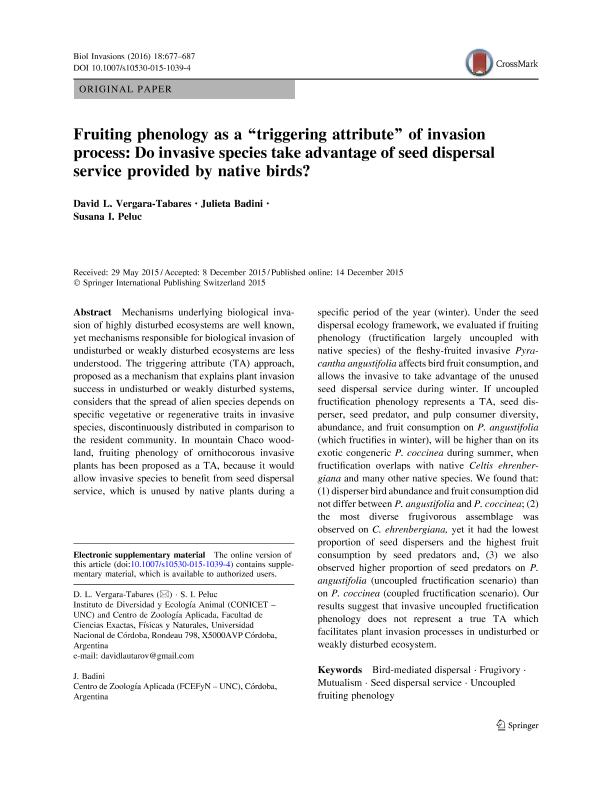Artículo
Fruiting phenology as a “triggering attribute” of invasion process: Do invasive species take advantage of seed dispersal service provided by native birds?
Fecha de publicación:
03/2016
Editorial:
Springer
Revista:
Biological Invasions
ISSN:
1387-3547
Idioma:
Inglés
Tipo de recurso:
Artículo publicado
Clasificación temática:
Resumen
Mechanisms underlying biological invasion of highly disturbed ecosystems are well known, yet mechanisms responsible for biological invasion of undisturbed or weakly disturbed ecosystems are less understood. The triggering attribute (TA) approach, proposed as a mechanism that explains plant invasion success in undisturbed or weakly disturbed systems, considers that the spread of alien species depends on specific vegetative or regenerative traits in invasive species, discontinuously distributed in comparison to the resident community. In mountain Chaco woodland, fruiting phenology of ornithocorous invasive plants has been proposed as a TA, because it would allow invasive species to benefit from seed dispersal service, which is unused by native plants during a specific period of the year (winter). Under the seed dispersal ecology framework, we evaluated if fruiting phenology (fructification largely uncoupled with native species) of the fleshy-fruited invasive Pyracantha angustifolia affects bird fruit consumption, and allows the invasive to take advantage of the unused seed dispersal service during winter. If uncoupled fructification phenology represents a TA, seed disperser, seed predator, and pulp consumer diversity, abundance, and fruit consumption on P. angustifolia (which fructifies in winter), will be higher than on its exotic congeneric P. coccinea during summer, when fructification overlaps with native Celtis ehrenbergiana and many other native species. We found that: (1) disperser bird abundance and fruit consumption did not differ between P. angustifolia and P. coccinea; (2) the most diverse frugivorous assemblage was observed on C. ehrenbergiana, yet it had the lowest proportion of seed dispersers and the highest fruit consumption by seed predators and, (3) we also observed higher proportion of seed predators on P. angustifolia (uncoupled fructification scenario) than on P. coccinea (coupled fructification scenario). Our results suggest that invasive uncoupled fructification phenology does not represent a true TA which facilitates plant invasion processes in undisturbed or weakly disturbed ecosystem.
Archivos asociados
Licencia
Identificadores
Colecciones
Articulos(IDEA)
Articulos de INSTITUTO DE DIVERSIDAD Y ECOLOGIA ANIMAL
Articulos de INSTITUTO DE DIVERSIDAD Y ECOLOGIA ANIMAL
Citación
Vergara Tabares, David Lautaro; Badini, Julieta; Peluc, Susana Ines; Fruiting phenology as a “triggering attribute” of invasion process: Do invasive species take advantage of seed dispersal service provided by native birds?; Springer; Biological Invasions; 18; 3; 3-2016; 677-687
Compartir
Altmétricas




